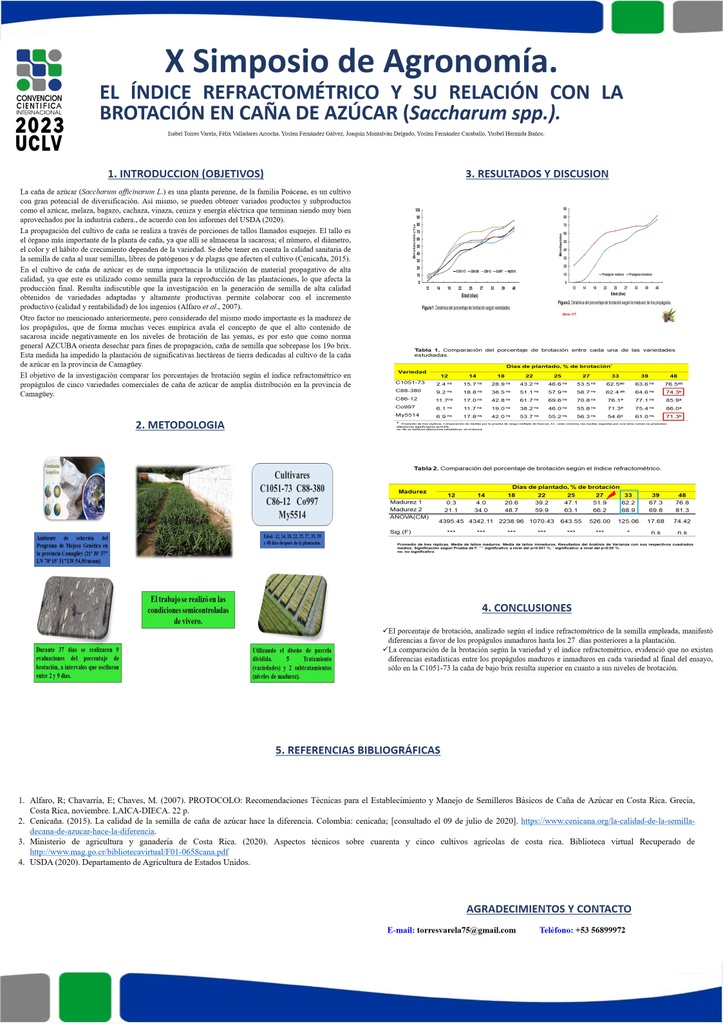Executive Secretary

9th International Scientific Conference on Agricultural Development and Sustainability
10th Symposium of Agronomy

Abstract
Problematic: to achieve a good population in a sugarcane plantation you need to have quality propagules that guarantee a good sprouting.
Objective: to compare the percentage of sprouting according to the refractometric index in propagules of five commercial varieties of sugarcane.
Methodology: A divided plot design was used, where the main treatments were the varieties, and the levels of maturity the subtreatments. Sprouting evaluations were performed for 37 days, at intervals ranging from two to nine days. Triple classification variance analysis was performed; means were compared by the Duncan multiple range test. The statistical program STATGRAPHICS Plus version 15.0 (2006) was used.
Results and discussion: it was shown that the beginning of sprouting can be delayed in mature propagules, but does not affect the final result in the emergency levels of the offspring at the end of this stage. The results showed that there are no statistically significant differences between mature and immature reeds in each variety at the end of the trial, only in C1051-73 the low Brix propagules were higher in terms of their sprouting levels. Among the shoots from mature and immature reeds there were no visual differences in vigor, rate of growth or cultivation.
Conclusions: the use of mature propagules does not constitute a limitation for the commercial planting of sugarcane, however, correct agrotechnical management with emphasis on soil moisture is essential.
Resumen
Problemática: para lograr una buena población en una plantación de caña de azúcar se necesita contar con propágulos de calidad que garanticen una buena brotación.
Objetivo: comparar los porcentajes de brotación según el índice refractométrico en propágulos de cinco variedades comerciales de caña de azúcar.
Metodología: Se utilizó un diseño de parcela dividida, donde los tratamientos principales lo constituyeron las variedades, y los niveles de madurez los subtratamientos. Durante 37 días se realizaron evaluaciones de brotación, a intervalos que oscilaron entre dos y nueve días. Se realizaron análisis de varianza de clasificación triple; las medias se compararon por la prueba de rango múltiple de Duncan. Se utilizó el programa estadístico STATGRAPHICS Plus versión 15.0 (2006).
Resultados y discusión: se demostró que el inicio de la brotación se puede retardar en propágulos maduros, pero no afecta el resultado definitivo en los niveles de emergencia de los vástagos a finales de esta etapa. Los resultados evidenciaron que no existen diferencias estadísticamente significativas entre cañas maduras e inmaduras en cada variedad al final del ensayo, sólo en la C1051-73 los propágulos de bajo Brix resultaron superiores en cuanto a sus niveles de brotación. Entre los brotes procedentes de cañas maduras e inmaduras no se apreciaron diferencias visuales en cuanto a vigor, ritmo de crecimiento o ahijamiento.
Conclusiones: el uso de propágulos maduros no constituye una limitante para la plantación comercial de caña de azúcar, sin embargo, es imprescindible un correcto manejo agrotécnico con énfasis en la humedad del suelo.
About The Speaker

Isabel Cristina Torres Varela

Discussion

